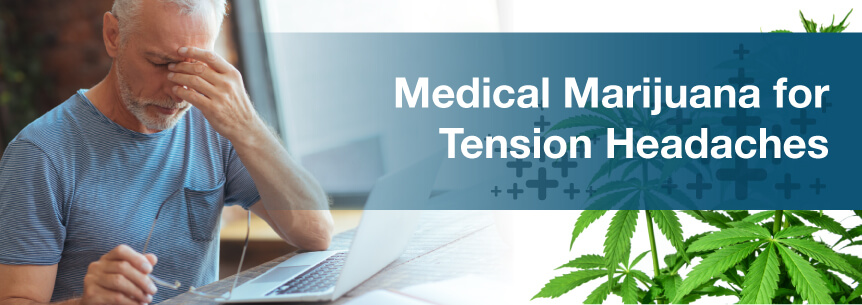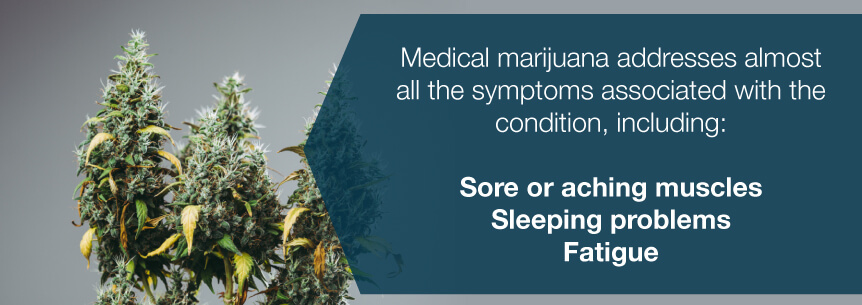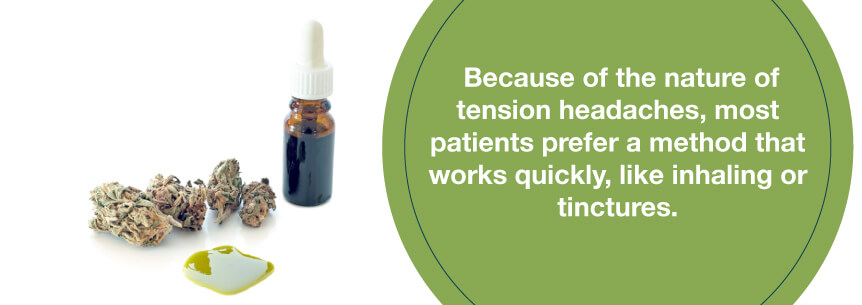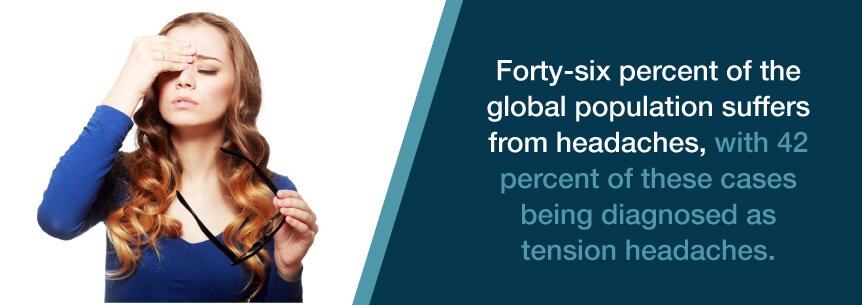
There are many different types of headaches. They vary from aches that pop up because of a hard day to chronic conditions that plague someone’s life. As the name implies, tension headaches, also known as tension-type headaches, are often the result of stress and tension in the sufferer’s daily life. Specific triggers, or causes of the stress and tension, will vary by patient, but the main culprits include work and relationships.
Although tension headaches typically don’t impede sufferers from going about their daily tasks, the condition adds complications and stress to people’s lives. Typical medications, even over-the-counter meds, can have serious side effects. Patients often become dependent and attempts to wean themselves off can lead to even more severe rebound headaches.
Medical marijuana is a viable method for reducing stress and tension in many patients. The calming effect many medical marijuana patients experience is well-documented, both throughout history and by current clinical studies. Patients suffering chronic tension headaches are finding relief from their worst symptoms by using cannabis medications.
Historical records show marijuana has been a headache remedy for centuries. The medical community accepted its ability to treat the symptoms of a headache well into the 20th century. Copious amounts of anecdotal and clinical evidence exists to support the proposition that medical marijuana can help tension headaches.
Patients who have tension headaches experienced the following benefits when using medical marijuana:
While some medical marijuana patients report increased anxiety when using medical marijuana, many find it provides a marked reduction in anxiety and tension. Individual body chemistry appears to be the key that determines whether cannabis increases or reduces anxiety and tension. For this reason, medical marijuana can be a valid alternative to traditional medications and an additional tool to any lifestyle changes aimed at reducing stress and anxiety.
Find A Doctor Find A Dispensary
The pathology, or cause, of tension headaches is unknown. However, some studies suggest inflammation in the muscles of the head, neck and face may contribute to, or cause, tension headaches. Numerous clinical studies have proven one of the major components of medical marijuana, cannabidiol (CBD), contains properties that relieve inflammation.
Along with reducing inflammation, CBD has been shown to reduce anxiety in patients, which may lead to a reduction in stress or tension in a tension headache sufferer.
More recently, clinical studies have shown that medical marijuana affects a brain substance known as anandamide. When the THC in marijuana reacts with anandamide, it produces a calming, relaxing effect that permeates the entire body in much the same way traditional anti-anxiety or anti-depression medications work.
Medical marijuana, however, does not increase serotonin levels, unlike many prescription medications used to treat tension headaches.
One of the primary reasons patients are pursuing medical marijuana to treat chronic tension headaches is that pot addresses almost all the symptoms associated with the condition, including:

The main symptom, however, patients address by using medical marijuana is headache pain. No matter what the cause, cannabis is an effective analgesic with incredible results. The main ways it treats pain are by:
Besides helping the symptoms associated with tension headaches, medical marijuana can also treat some of the common causes of the condition, including:
Cannabis and tension headaches could be an effective treatment for you, especially if you suffer from chronic headaches. Not only can you use it at the onset of a headache, but it can also be effective at preventing tension headaches from occurring.
Tension headaches usually affect both sides of the head and can also cause pain to radiate to other parts of the body including the neck, eyes and different muscle groups. Because of this, doctors frequently prescribe muscle relaxers to ease tension and headache pain.
When looking for a cannabis strain to treat tension headaches, patients should find one that has the same ability to relax muscles and ease headache pain. Some of the best strains for tension headaches include:
Many different strains of marijuana effectively combat headache pain. Although the above list is a good place to start, be sure to ask your local budtender for recommendations, as these strains may not be available at your medical marijuana dispensary.
There are many different ways a patient can consume medical marijuana. Because of the nature of tension headaches, most patients prefer a method that works quickly, like inhaling or tinctures. However, ingesting medication orally and using topicals also offer distinct benefits. Here is a breakdown of some of the benefits and drawbacks of different methods of ingestion.

If you’re struggling with chronic and severe pain because of your tension headaches, you may be able to receive medical marijuana medications. Many states have approved chronic pain as a criterion for receiving a recommendation for cannabis use.
The first step is to speak to a medical marijuana doctor. They can assess your condition and determine if you qualify. Once you receive a recommendation from your physician, you can apply to your state’s medical cannabis program. Don’t live another day struggling with tension headache pain. Contact a doctor in your state approved to recommend medical marijuana.
Find A Doctor Find A Dispensary
The most common headache is a tension headache. Although migraines are considered a more severe form of headache, tension headaches can be just as painful and cause the patient to suffer acutely. They tend to come on slowly and can affect the entire head with throbbing pain, including the forehead, neck and back of the head.
Tension headaches are just one category of headache, but they have distinct causes and symptoms. Some patients do not know how to distinguish a tension headache from other types of headaches because some of the characteristics overlap. Tension headaches are mild to moderate in intensity and affect both sides of the head, lasting from a matter of minutes up to 30 to 60 days or more.
Patients with tension headaches say it feels like a clamp is squeezing their skull, or a tight band is encircling their forehead. This condition is also called a stress headache.
Tension headaches can either be episodic or chronic.
Although the condition is benign, tension headaches can significantly disable a person’s life when they become chronic and intractable. When a patient suffers from tension headaches over a long period of time, it can put a strain on their professional and personal life.
When a patient experiences a tension headache, it usually develops gradually in the middle of the day. It may get stronger, or it may let up a little bit, but the symptoms continue throughout the rest of the day. They are not genetic, so tension headaches don’t “run in the family.”

There is not one specific cause that’s the same for every single patient. Stress seems to be the main culprit for tension headaches. However, each patient has a trigger that induces the onset of a headache. These triggers can include:
Episodic and chronic tension headaches have different characteristics. Episodic headaches arise due to a particularly stressful situation or if a patient allows stress to build up. Patients with chronic tension headaches usually struggle with daily strain.
Another common cause of tension headaches is muscle tightening, especially around the neck and scalp. Tense muscles can be the result of:
Unfortunately, tension headaches can also arise with no clear cause. Even patients who do not report experiencing stress or tightened muscles can have these types of headaches.
If you experience chronic tension headaches, your doctor may want to run additional tests to ensure they’re not the result of an underlying condition.
The symptoms of tension headaches can be similar to those experienced by patients with migraines or another kind of headache. The main difference is that the pain associated with tension headaches starts later in the day, and most people can go on without it interrupting their daily activities.
Some of the most common side effects of tension headaches can include a combination of the following:
In general, tension headaches do not share many of the nerve symptoms associated with migraines or other types of headaches. Patients don’t usually experience vision issues or blurred vision, balance problems, loss of strength, muscle weakness, nausea or vomiting and intense sensitivity to noise or light.
All ancient medical records reference people suffering from headaches or migraines. One could argue the condition is as old as humanity itself. As far back as 7000 BCE, there’s evidence Neolithic civilizations practiced a primitive form of neurosurgery called trepanation. Though we now know trepanning the skull can help relieve pressure and increase blood flow to the brain, some scientists have argued ancient people may have viewed trepanation as a way to release evil spirits.
An Egyptian papyrus dating to 1200 BCE describes migraine and headache symptoms in explicit detail, showing the condition hasn’t changed much over the years. Both Ancient Greek and Roman medical experts wrote in detail about headaches and attempted a variety of treatments. During the Middle Ages, poultices soaked in vinegar and opium were a common headache remedy.
In 1672, Thomas Willis introduced the term “neurology.” He also made several observations about what caused headaches, pointing out heredity, seasonal changes, atmospheric conditions and diet as factors. He also came up with the vascular theory of headaches, which stated migraines were caused by overly reactive blood vessels.
In the late 1800s, William Gowers — known today as one of the founders of modern neurology — published an influential textbook about neurology. One treatment he highly recommended was the use of marijuana to treat acute headaches.
Continuing through the centuries, physicians and researchers sought to ascertain the cause of headaches and migraines. They discovered different physiological developments that occur when patients suffer from headaches. They also found contributing factors.
In 1985, the International Headache Society developed a classification system to differentiate between the different types of headaches. Today tension-type headaches, both episodic and chronic, are included as one of the categories of headaches.

If patients have chronic or recurring headaches, they should make an appointment with a physician. Their doctor will conduct a physical and possibly some neurological exams to determine what type of headache the patient suffers from. Physicians usually ask sufferers to describe the pain to determine which category of headache a patient has. These include:
Because tension headaches differ in their location and intensity from other types of headaches, most doctors can make a diagnosis after speaking with the patient about their symptoms. However, they may want to rule out more serious conditions if headaches are overly complicated or severe. The two most common tests used to provide doctors with images of a patient’s brain are magnetic resonance imaging and computerized tomography.
Many patients wish to avoid using medication of any kind to treat their tension headaches. There are a few things they can try to keep them from developing headaches, most of which are lifestyle changes.
Since a patient’s unique trigger often brings about tension headaches, the use of a headache diary may help a sufferer find the main culprit. Doctors may recommend a patient record meals, activities and other variables that may have caused stress each time they experience a headache. After a few weeks or months, patients may be able to determine a connection. Once they know their trigger, they can avoid it and prevent future tension headaches.
Unfortunately, even practicing all these techniques does not always help prevent tension headaches. In those cases, physicians may recommend the use of over-the-counter or prescription pain medications.
Even though headaches are one of the most common afflictions people experience, there is no cure for the condition. All medications or treatments physicians recommend are to help treat the symptoms, not cure the tension headache itself.
Most doctors recommend treating tension headaches as soon as symptoms begin to develop. In this way, the headache can be addressed before the pain becomes too severe. The goal of any treatment is to relieve current pain and prevent any future headaches from developing.
The traditional treatments for tension headaches include the use of over-the-counter (OTC) pain medications or prescription pain medications, but both come with significant negative side effects. Even OTC pain medications such as aspirin, ibuprofen or acetaminophen can increase the risk of heart attack or stroke and cause serious damage to internal organs with prolonged use.
In addition, frequent use of OTC pain medications can cause another type of headache known as a rebound headache. Rebound headaches occur when a patient uses OTC pain medication frequently and then suddenly stops, causing withdrawal symptoms including headaches.
When OTCs do not work, your doctor may prescribe either a stronger pain medication, antidepressants or a prescription muscle relaxant. They recommend taking this medicine every day, even if a patient isn’t experiencing a tension headache, to prevent pain from developing.
Pain relief, anti-depression and anti-anxiety prescription medications carry the risk of overdose, dependency and addiction, as well as a host of other potential negative side effects. Medical marijuana may provide the same pain relief without the negative side effects.